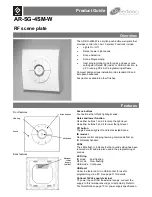
3
the unit. Proper insulation of chilled process fluid
piping is crucial to prevent condensation. The
formation of condensation adds a substantial heat
load to the cooling system.
The importance of properly sized piping cannot be
overemphasized. See the ASHRAE Handbook or
other suitable design guide for proper pipe sizing. In
general, run full size piping out to the process and
then reduce the pipe size to match the connections
on the process equipment. One of the most
common causes of unsatisfactory unit performance
is poor piping system design. Avoid long lengths of
hoses, quick disconnect fittings, and manifolds
wherever possible as they offer high resistance to
water flow. When manifolds are required, install
them as close to the use point as possible. Provide
flow-balancing valves at each machine to assure
adequate water distribution in the entire system.
Install shut-off valves at each machine to allow for
isolation of the unit.
Installation - Electrical
All wiring must comply with local codes and the
National Electric Code. Minimum Circuit Amps (MCA)
and other unit electrical data are on the unit
nameplate. A unit specific electrical schematic ships
with the unit. Measure each leg of the main power
supply voltage at the main power source. Voltage
must be within the voltage utilization range given on
the drawings included with the unit. If the measured
voltage on any leg is not within the specified range,
notify the supplier and correct before operating the
unit. Voltage imbalance must not exceed two
percent. Excessive voltage imbalance between the
phases of a three-phase system can cause motors to
overheat and eventually fail. Voltage imbalance is
determined using the following calculations:
% Imbalance = (Vavg – Vx) x 100 / Vavg
Vavg = (V1 + V2 + V3) / 3
Vx = phase with greatest difference from Vavg
For example, if the three measured voltages were
442, 460, and 454 volts, the average would be:
(442 + 460 + 454) / 3 = 452
The percentage of imbalance is then:
(452 – 442) x 100 / 452 = 2.2 %
This exceeds the maximum allowable of 2%.
There is a terminal block for main power connection
to the main power source. The main power source
should be connected to the terminal block through
an appropriate disconnect switch. There is a separate
lug in the main control panel for grounding the unit.
Check the electrical phase sequence at installation
and prior to start-up. Operation of the unit with
incorrect electrical phase sequencing will result in
improper pump performance. Check the phasing
with a phase sequence meter prior to applying
power. The proper sequence should read “ABC” on
the meter. If the meter reads “CBA”, open the main
power disconnect and switch two line leads on the
line power terminal blocks (or the unit mounted
disconnect). Do not interchange any load leads that
are from the unit contactors or the motor terminals.
WARNING: This equipment contains hazardous
voltages that can cause severe injury or death.
WARNING: This equipment contains hot water or
coolant under pressure. Accidental release of hot water
or coolant under pressure can cause personal injury
and or property damage.
WARNING: This equipment may contain fan blades or
other sharp edges. Make sure all fan guards and other
protective shields are securely in place.
WARNING: The exposed surfaces of motors, piping,
and other fluid circuit components can be very hot
and can cause burns if touched with unprotected
hands.
CAUTION: Disconnect and lock out incoming power
before installing, servicing, or maintaining the
equipment. Connecting power to the main terminal
block energizes the entire electric circuitry of the unit.
Electric power at the main disconnect should be shut
off before opening access panels for repair or
maintenance.
CAUTION: Wear eye protection when installing,
maintaining, or repairing the equipment to protect
against any sparks, debris, or fluid leaks.
CAUTION: Wear protective gloves when installing,
maintaining, or repairing the equipment to protect
against any sparks, debris, or fluid leaks.
CAUTION: Wire the unit ground in compliance with
local and national codes.
Содержание Oiltherm RO
Страница 1: ......
Страница 2: ......
Страница 18: ...14 Drawings Charts Figure 1 Pump Curve 60 Hz ...
Страница 19: ...15 Figure 2 Cooling Capacity ...
Страница 20: ...16 Figure 3 High Voltage Wiring Diagram ...
Страница 21: ...17 Figure 4 Low Voltage Wiring Diagram ...
Страница 22: ...18 Figure 5 Control Board Details ...
Страница 23: ...19 Figure 6 Heating Element Details ...
Страница 26: ...Notes ...
Страница 27: ......








































